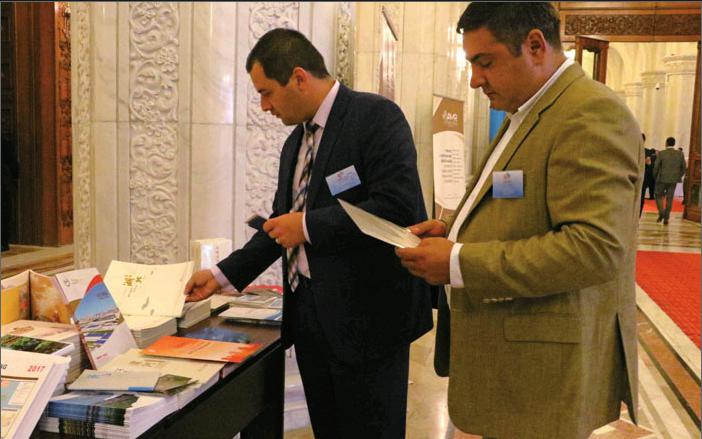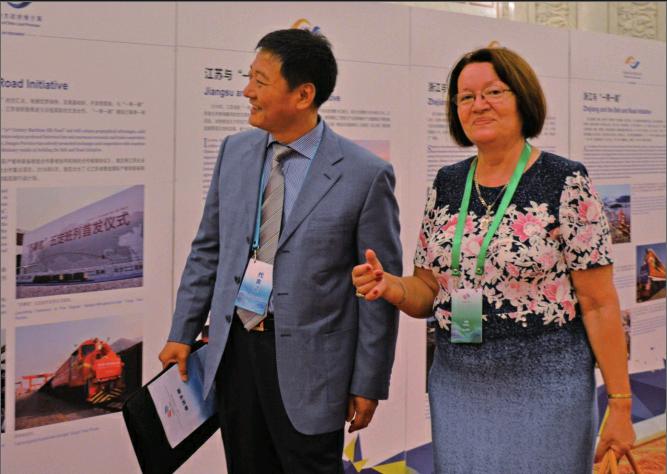Bonding in Bucharest
2017-08-03ByBaiShi
By+Bai+Shi


While political parties may be divided on domestic and foreign issues, there is a rare unanimity among the parties of Central and Eastern European (CEE) countries when it comes to their recognition of the Belt and Road Initiative.
Over 600 delegates from the spheres of politics and business gathered at the Palace of Parliament, the worlds second largest administrative building, in the Romanian capital Bucharest on July 14 to attend the 2017 China-CEE Countries Political Parties Dialogue. A total of 35 parties from 16 CEE countries, including both ruling and opposition parties from the right, center and left wings, sent their representatives.
The event was co-chaired by the International Department of the Central Committee of the Communist Party of China (IDCPC) and Romanias ruling Social Democratic Party (PSD). The first dialogue between political parties within the 17-member China-CEE 16+1 cooperation framework was held in Budapest, Hungary, in 2016.
Song Tao, IDCPC Minister, said China is confi dent of building up the 16+1 cooperation into an important link connecting the Belt and Road with the European Union.
“The CEE countries are located in the center of Eurasia and have good economic conditions. They can play a more important role in linking the Asia-Pacifi c and European economic circles,” Song said.
He urged all parties to build five platforms: dialogue between political parties, people-to-people friendship, mutual learning among civilizations, pragmatic cooperation and youth exchange.
Collaboration sans strings
Qian Naicheng, head for Central and Eastern European Affairs at IDCPC, told Beijing Review that communication and exchanges between political parties of different countries play an important role in diplomacy.
“The CPC is willing to develop relations with any foreign political party without ideological precondition,” Qian said. “China and CEE countries have maintained sound relations and a stable friendship which have withstood changes in the international landscape.”
Since China and the CEE countries held their fi rst leaders meeting and initiated the 16+1 cooperation framework in April 2012, the dialogue between political parties has become an important pillar of China-CEE countries cooperation. Qian said compared with last year, the 2017 Bucharest dialogue saw more delegates who participated in a variety of agendas.
A business delegation from six Chinese provinces also visited Bucharest to explore business opportunities during the period.
The dialogue was comprised of three parallel forums: a youth forum, one on local promotion and a third on business cooperation, with the theme of advancing the Belt and Road Initiative.
Istvan Hollik, member of the Hungarian National Assemblys Economic Committee and the Committee on European Affairs, said the conference was about two things: “dialogue and the future.”
Hollik, who also attended the first dialogue in 2016, called the event a unique form of communication giving both Central Europeans and the Chinese politicians an opportunity to understand each other in greater depth and breadth.
“It is also a channel for exchanges between two civilizations. The prerequisite of a successful cooperation is mutual understanding and trust, which is what this conference builds,” he said.
The next China-CEE summit will be held in Hungary in autumn.
Focus on Belt and Road
At the Bucharest dialogue, delegates expressed great expectations about the initiative.
In 2013, Chinese President Xi Jinping proposed the Silk Road Economic Belt and the 21st-Century Maritime Silk Road, collectively known as the Belt and Road Initiative, for building connectivity and promoting common development. The initiative has since become a focus of the cooperation between China and CEE countries.
“The Belt and Road Initiative has led us to… rebuilding the Silk Road, which in the past benefited both Europe and China, and will benefit both regions in the future as well,” Hollik said.
Hungary, Serbia, and China are building the Budapest-Belgrade railway line together. The corridor from the Port of Piraeus in Greece will be a route accelerating the fl ow of goods between Europe and China.
Hollik said the railway line is a priority for the Hungarian Government.
“We are proud that Chinese investments contribute to our growth. We are convinced that Central Europe is the gateway for Chinese capital to Europe. We are also convinced that the cooperation between the 16 and China is benefi cial not only for us, but for the whole of Europe,” he said.
Liviu Dragnea, PSD Chair, said in his keynote speech at the dialogue that the Belt and Road Initiative as well as the China-CEE countries cooperation mechanism would bring broad prospects to the development of Romania-China relations of mutually benefi -cial cooperation.
“Romania attaches great importance to its relations with China,” Dragnea said. “[It] has confi dence and resolution to turn their friendship into practical outcomes and inject new vitality into bilateral ties.”
Marian Neacsu, PSD General Secretary, said thanks to the CPC and the Belt and Road Initiative, different parties from the CEE countries could set aside their differences and come to Bucharest for the event. “The dialogue will promote the implementation of the Belt and Road Initiative and cooperation between China and the CEE countries,”Neacsu said.
Jan Hamacek, Speaker of the Czech Parliament and Deputy Chairman of the Czech Social Democratic Party (CSSD), said an essential element of the strategic partnership between the Czech Republic and China is the formers participation in the Belt and Road Initiative. “This initiative is a great example of peaceful cooperation among nations. I take pride in the fact that the Czech Republic has become a leader in spearheading the Belt and Road Initiative in the region,”Hamacek said.
He pointed out that last year, the Czech Republic had signed the Action Plan for Cooperation under the framework of the Belt and Road Initiative in Riga. “Now we are about to launch the Czech-Chinese Center for Cooperation, the fi rst center of its kind in the region,” he added. “It will facilitate CzechChinese cooperation on priority projects within the framework of the Belt and Road.”
In 2012, the CSSD and CPC signed a memorandum of cooperation for developing wide-ranging cooperation between the two parties.
“This intensifi cation of cooperation along party lines has proved crucial in setting in train a bold restart of Czech-Chinese relations,” Hamacek said.
In 2013, the CSSD won the elections and implemented its China policy at the government level. There was a qualitative improvement in bilateral relations in a number of important areas, such as finance, regional development, healthcare and cultural cooperation.
An exhibition on the Belt and Road Initiative was held on the sidelines of the dialogue, providing background information as well as an update on the progress of the initiative in different countries.
Klemen Gliha, a delegate from the Democratic Party of Pensioners of Slovenia, looked at it carefully. “It is a great idea to connect people living in different regions and promote business growth,” he said.
Gliha, who traveled to south China last year, said he was astonished by the rapid development in China.
Slovenia and China will celebrate the 25th anniversary of their diplomatic relations this year.
Gliha, who is in charge of youth work in his party, said many young Slovenian people have some knowledge of the Belt and Road Initiative and expect mutual benefi ts from it.
Sergejs Potapkins, a Democrat member of Latvias Parliament, said his party attaches great importance to relations with China.
“We are highly interested in Chinas development and are consistently in touch to receive information about the Belt and Road and learn about new situations, trends as well as opportunities,” Potapkins said.
In November, Chinese Premier Li Keqiang paid a state visit to Riga, Latvia, and attended the fi fth China-CEE Countries 16+1 leaders meeting there.
The Chinese and Latvian governments signed a number of cooperation documents. China announced an investment fund of $11 billion to finance Belt-and-Road projects in CEE countries.
“Now we are implementing some infrastructure projects with the help of the fund and welcome Chinese companies to participate,” Potapkins said. “We hope to see fast growth in Chinese investment in Latvia after Premier Lis visit.”
Latvia is rich in fishery resources and products which have a market in China.
The opposition parties attending the dialogue also agreed about the huge potential in China-CEE countries cooperation.
Michal Ludwikowski, representing the Polish Peoples Partys (PPP) foreign affairs section, said cooperation with China on the governmental level or party level would bring more opportunities for both sides.
“The initiative will create peace, stability and benefi ts for the people in future,” he said
Though his party sits in opposition in parliament, Ludwikowski said it is “an old friend of China.”
The PPP was founded in 1895. “We have been cooperating with the CPC since the two countries established diplomatic relations in 1949,” he said. “Our party is promoting the implementation of the Belt and Road Initiative.”
With direct air routes, traveling to Beijing has become faster and more convenient.There is also a railway link between Poland and China. “So Poland and China have become close neighbors,” Ludwikowski said.
Describing his country as the place where the East meets the West, he said it has a rich culture and beautiful landscape and has seen a jump in the number of Chinese tourists in recent years.
“Poland benefi ts from the growing ties with China. There is no area in which they cant cooperate,” Ludwikowski added.
